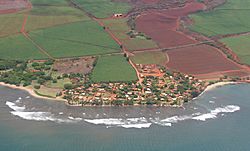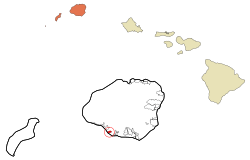Kaumakani, Hawaii facts for kids
Quick facts for kids
Kaumakani, Hawaii
|
|
|---|---|

2004 aerial view of Pakala Village
|
|

Location in Kauai County and the state of Hawaii
|
|
| Country | United States |
| State | Hawaii |
| County | Kauai |
| Area | |
| • Total | 1.06 sq mi (2.74 km2) |
| • Land | 0.95 sq mi (2.46 km2) |
| • Water | 0.11 sq mi (0.29 km2) |
| Elevation | 151 ft (46 m) |
| Population
(2020)
|
|
| • Total | 672 |
| • Density | 708.11/sq mi (273.47/km2) |
| Time zone | UTC-10 (Hawaii-Aleutian) |
| ZIP code |
96747
96769 |
| Area code(s) | 808 |
| FIPS code | 15-30650 |
| GNIS feature ID | 0360693 |
Kaumakani is a small community located on the island of Kauaʻi in Hawaiʻi, United States. It is a "census-designated place" (CDP). This means it's an area that the government defines for collecting statistics, but it's not a formally incorporated town. The name Kaumakani means "place in the wind" in the Hawaiian language. In 2020, about 672 people lived there.
Contents
History of Kaumakani
For over 40 years, Kaumakani was known as "Makaweli." In the Hawaiian language, Makaweli means "fearful features." Makaweli was also an ancient land division called an [[ahupuaʻa]]. An ahupuaʻa was a traditional land area in Hawaiʻi, usually shaped like a wedge, running from the mountains to the sea.
In 1914, the United States Board on Geographic Names decided the community should be called Makaweli. However, in 1956, they officially changed the name to Kaumakani.
Post Offices and ZIP Codes
Kaumakani has its own post office with the ZIP code 96747. This post office is open only in the mornings.
In 2008, a small community nearby, called Pākalā Village, became its own CDP. Pākalā Village has its own post office named "Makaweli" with ZIP code 96769. This post office is open only in the afternoons. The name Pākalā means "the sun shines" in Hawaiian.
A place called Makaweli Landing at Pākalā was once known as "Robinson's Landing." This was because the Robinson family used to run a private ferry from there to their island of Niʻihau.
Geography of Kaumakani
Kaumakani is located on the southern coast of Kauaʻi island. Its exact location is at 21°55′13″N 159°37′27″W. The main road that runs through the area is Kaumualiʻi Highway, also known as Route 50.
The Kaumakani CDP covers a total area of about 2.74 square kilometers (1.06 square miles). Most of this area, about 2.46 square kilometers (0.95 square miles), is land. The remaining 0.29 square kilometers (0.11 square miles), or about 10.46%, is water.
Climate
Kaumakani has a warm and pleasant climate, typical of Hawaiʻi. Temperatures are generally mild throughout the year, with warm days and comfortable nights. The area receives some rainfall, but it's usually sunny, making it a nice place to live.
Population and People
| Historical population | |||
|---|---|---|---|
| Census | Pop. | %± | |
| 2020 | 672 | — | |
| U.S. Decennial Census | |||
In 2000, there were 607 people living in Kaumakani. By 2020, the population had grown to 672 people. This means more people are choosing to live in this community.
Community Details
In 2000, there were 207 households in Kaumakani. A household is a group of people living together in one home. Out of these, 33% had children under 18 years old. About 60% were married couples living together.
The average household had about 2.93 people, and the average family had about 3.34 people.
Age and Diversity
The population in Kaumakani is spread across different age groups. In 2000:
- 26% of the people were under 18 years old.
- 6% were between 18 and 24 years old.
- 28% were between 25 and 44 years old.
- 20% were between 45 and 64 years old.
- 20% were 65 years old or older.
The median age was 40 years. This means half the people were younger than 40, and half were older.
The community is also diverse. In 2000, the racial makeup included:
- 77% Asian
- 16% from two or more races
- 4% White
- 2% Pacific Islander
- Less than 1% from other races
About 5% of the population identified as Hispanic or Latino.
Income and Economy
In 2000, the median income for a household in Kaumakani was $34,583 per year. For families, the median income was $41,250. The per capita income, which is the average income per person, was $14,024.
About 9% of families and 11% of the total population lived below the poverty line. This included 11% of those under 18 and 8% of those 65 or older.
See also
 In Spanish: Kaumakani para niños
In Spanish: Kaumakani para niños

